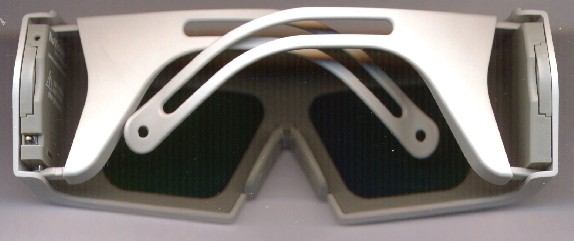
The unofficial
NuVision 60GX page
Quick info:
The 60GX by NuVision
is a professional wireless shutterglasses system. It's very similar to
the StereoGraphics CrystalEyes2 glasses and controllers. In a nutshell:
The NuVision 60GX controller has some advantages over the StereoGraphics
units, while the glasses - although good - can't beat the CrystalEyes2.
The LCD-panels are about as large as those of the CrystalEyes, which is
excellent.
The 60GX comes in two versions:
1) SR: IR-emitter with mini-DIN-3 plug
for stereo-ready graphics board and workstations
2) NSR: IR-emitter with mini-DIN-3 plug
plus external VGA-pass-through box with sync-doubling and auto-sync (a
two-in-one package)
The sync-doubler of the NSR version
which handles the popular above-below splitscreen 3D format enables the
60GX to work with the largest range of professional applications available
as well as with the Wicked3D range of consumer 3D-accelerators and drivers.
Unlike the StereoGraphics sync-doubler
the 60GX doesn't require 'SimulEyes white line code' in page-flipping mode.
Due to this fact the 60GX is compatible to all known interlace and page-flipping
drivers available including LCD-BIOS, VR-BIOS, SSDI, 3D-Win. The 60GX-NSR
also works for the new ELSA graphics boards and ELSA Revelator drivers.
There is no 'line-blanker' mode of course.
This review isn't
intended for beginners. Please consult the Basics
and FAQ pages if questions arise.
This page was innitially released on July 10, 1999
last update:
Related Links:
NuVision
StereoGraphics
CrystalEyes2 review
ELSA
Wicked3D review
Wicked3D


Pro
|
Con
|
Glasses
|
Glasses
|
+ pi-cell shutters
+ activation LED on glasses
+ very large panels (rivals
CE2)
+ activated by bows
|
- shutters active
all the time
- pressure on nose in some
cases, especially when used with prescribed glasses
- no reverse button on glasses
- no headtracking option/version
(as CE2-VR)
|
SR-Controller/IR-emitter
|
SR-Controller/IR-emitter
|
+ VESA compliant
mini-DIN-3 stereo connector
+ connects to DIN 3, 5,
7, DB9, 3.5 mm
+ DIN 7 and DB9 adaptors
already in package
+ StereoGraphics IR-Code
compatible
+ Status-LED
+ small, adjustable IR-emitter
+ reverse switch
|
- no IR-range control
|
NSR-Controller
|
NSR-Controller
|
+ king of compatibility
+ Sync-Doubler, VGA-pass-through
& DIN-3 in one
+ precise, high-quality
synchronization
+ controller seperated from
IR-emitter
+ reverse button on IR-emitter
& controller
+ good, easy to reach buttons
on front of box
+ manual control of all
functions
+ works with all known drivers,
i.e. LCD-BIOS, VR-BIOS, WinSPEX, NuvFrag, eyeSCREAM, ELSA Revelator
+ supports page-flipping,
interlace and above-below
+ Status-LED's on controller
& emitter
+ buttons on front of controller
+ power over VGA-board or
external
|
- stereo orientation
may flip in case of software-page-flipping slipups (can happen with LCD-BIOS,
ELSA Revelator-driver and such)
- doesn't listen to WLC
- no line-blanker
- VGA-dongle may block other
connectors on graphics board (for example: Voodoo2 VGA-in, ELSA Erazor
III video cable)
|
Driver
|
Driver
|
+ no driver in package,
but NSR works with any known driver (software page-flipping may cause slipups
though)
|
- no driver in package
|
Misc
|
Misc
|
+ good documentation
with connection schemes for any graphics system
|
- no software bundle
|
The IR-emitter (VESA miniDIN-3)
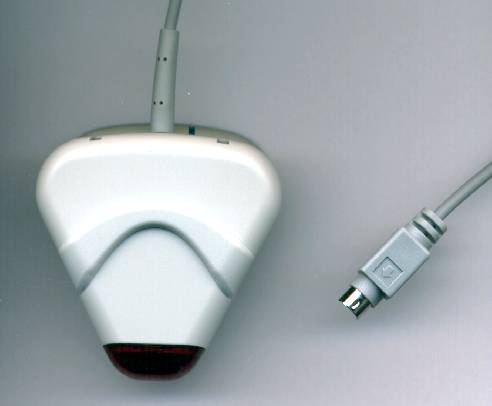
The controller for stereo ready workstations is just an IR-emitter with
fixed cable and VESA mini-DIN-3 stereo jack. No external power required.
It's small, steady and the incliniation can be altered. There's also a
little stereo-reverse-switch on the back, which hasn't to be used often
on a DIN-3 system.
The emitter just plugs into a stereo ready workstation or hi-end gfx-board
with mini-DIN-3 stereo connector. There are adaptors for other stereo-ready
systems available, i.e. DIN-5, DIN-7, DB9, 3.5 mm stereo jack. I found
adaptors for DIN-7 and DB9 in the package already. I suggest to ask NuVision
for the proper adaptor when ordering.
The NSR controller/emitter
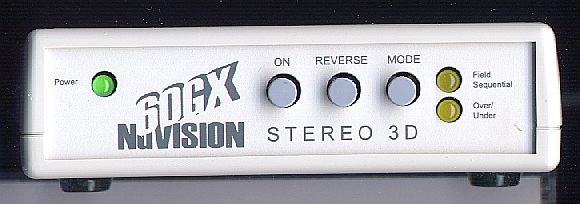
The controller for non-sterero-ready systems (NSR) can be connected
to any standard VGA-connector via a VGA-pass-through cable. All buttons
are on the front of the box where they belong (opposed to the StereoGraphics
EPC2).
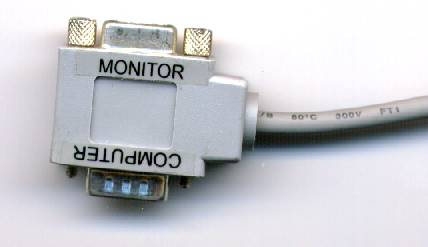
The VGA-pass-through dongle of the 60GX. The cable on the side can cause
problems with other connectors on the VGA-board, i.e. with the pass-through
connector of Voodoo boards or special video-connectors as on the Erazor
3.
The impact on the VGA-signal-quality is low.

DIN-3 outlet on the back
of the box
On the back you'll find a power socket which isn't required in all cases,
since the NSR is able to draw power directly from newer VGA-boards. You'll
also find a VESA compliant mini-DIN-3 outlet. The DIN-3 IR-emitter can
be plugged in here appart from any other DIN-3 emitters or glasses. That's
what makes the 60GX an all-in-one solution. The NSR package connects to
anything.
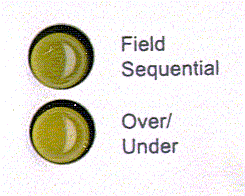
The mode button switches between sync-doubler and page-flipping mode.
The refresh rate is doubled in sync-doubler mode which eliminates flicker
in all cases, but may cause trouble on some monitors. This technology doesn't
require any driver software and works for any operating system. The only
thing you need is some above-below stereo format software, such as professional
applications or Wicked3D powered stereo games.
The NSR sync-doubler controller also reacts to field-sequential modes
(i.e. interlace or page-flipping). Unlike it's StereoGraphics counterpart
(EPC2) it doesn't require White Line Code. If WLC is present it's just
ignored. Although WLC is usually a pain in the... it
has advantages. It controls the stereo-orientation automatically and the
user hasn't to reach for the reverse-button every now and then. Since WLC
is so rarely used in software it's not a major drawback for the 60GX not
to support it.
Field-sequential modes require a gfx-chipset-specific driver software.
The 60GX-NSR supports all of them. Some are only available as a bundle
with some hardware, like the eyeSCREAM drivers or VR-BIOS. Others are available
for Download on the web, like LCD-BIOS. Just check the Driver-page.
There is no driver delivered with the 60GX.
Power
The power supply of the NSR-controller is just great. It gets the power
from the VGA-card - if available.
What NuVision says about the power supply for the NSR controller:
'Most graphics cards manufactured today are built to a new VESA standard
protocol which calls for power (plus other things) on the card. To
distinguish these cards from the older cards the manufacturer is suppose
to use a blue molded 15 pin plug. As you will see from your own inventory,
this accounts for about 80% of the cards being manufactured today.
I do not have a list of who does and who does not provide power.
That is why we supply a separate power supply with the product. Until
we feel confident that our customers have or are buying graphics cards
that have the VESA standard blue plug we will continue to supply separate
power.'
taken from the NuVision 60GX manual
by permission
Silicon Graphics
Workstations
SUN
Workstations
Intergraph
and DEC Workstations
Standard
PC
In sync-doubler mode flicker isn't an issue. Refresh rates start usually
at 120 Hz. In page-flipping mode flicker may be a problem. Try to choose
higher refresh rates using the windows setup, the utilities which came
with your graphics card or some 3rd party utility like Scitech Display
Doctor.
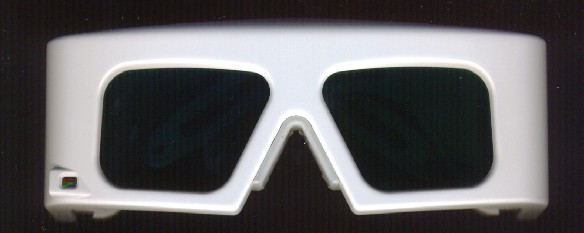
The glasses got really large LCD-panels, comparable to the CrystalEyes2.
The field of view is more than satisfying.
The 60GX glasses are activated by opening the bows, like CE2 and H3D.
The frame is large and fits even over the biggest prescribed glasses.
I'm not entirely happy with the nose-piece. It's large and soft, but may
become uncomfy after longer use. It also seems to be optimized for use
without prescribed glasses, i.e. the nose-piece must sit on the highest
point of the nose. When used with prescribed glasses it either rests on
them adding to the overall weight, or the 60GX sits on a lower point of
the nose and causes some pain.
The pi-cell shutters
NuVision continues to use pi-cell shutterglasses, like they did in the
3D-SPEX product. Pi-cells are said to have some advantages over other LCDs
in terms of speed and dynamic range (the difference in light blocking between
open- and close-states). The pi-cells have some disadvantages also. While
they're shut-off they're not clear. Usually such pi-cell glasses remain
dark blue/green, like sunglasses when off. There's a warm-up/cool-down
phase also in which the panels become spotty and the vision is impaled.
With the old 3D-SPEX consumer pi-cell glasses the users had to live with
that. For the 60GX NuVision looked for another solution. They just power
the glasses all the time as long as they're worn. While the stereo-mode
is deactivated, for example when switching back to the windows-desktop
during 3D-sessions the glasses go into some non-synchronized, high-speed
shutter-mode. Thus the glasses remain clear all the time and they react
immediately without warm-up/cool-down. When looking on a high-refresh windows
desktop you may see some artifacts due to the shuttering. The image may
show slightly darker areas or some beating/pumping. All in all I'd prefer
the clear standard glasses of the CrystalEyes2.
What NuVision says about the clear status:
'...we do cycle the electronics in the glasses in order to maintain
the clear state. You do see some beating against non-stereo monitors.'
What NuVision says about the pi-cell panels:
'The "pi-cell" is a fast switching cell that can support in excess
of 180 Hertz refresh rates. It is a thin cell which contributes to
an excellent viewing angle through the glasses. You do not have to
be right in front of the display, nor do you have to look directly through
the lenses at a particular angle to get good extinction. It is the
same excellent technology we have used in our passive stereoscopic systems
for the last 15 years. The "pi-cell" is manufactured for NuVision
under a license granted by Tektronix.'
Please check the X-RAY Lab for a weight&size
comparison of various shutterglasses, including the 60GX.
The SR (stereo ready) controller/IR-emitter requires a stereo ready
workstation or graphics board with dedicated stereo-connector. Such connectors
come in the shape of VESA mini-DIN-3, mini-DIN-5, mini-DIN-7, Sub DB9 or
3.5 mm stereo jack. The 60GX controller has a mini-DIN-3 plug. Adaptors
are available. The DIN-7 and DB9 adaptors were already in the test-package.
Special stereo-drivers for your graphics card are obligatory. This
isn't in the hands of the glasses manufacturer. Ask your graphics hardware
vendor for stereo-driver support. There may be lacking driver support even
if there's a dedicated stereo-connector on the board!!!
The NSR sync-doubler controller connects to any graphics card
with 15-pin standard VGA-connector. No drivers for the graphics hardware
are required in sync-doubler mode since the flipping of the stereo-images
is done by the controller. Stereo-software or stereo-plug-ins are required
however.
The over-under split-screen stereo format handled by the NSR
controller is very popular in professional applications. It's also used
in the Metabyte Wicked3D drivers for consumers. The NSR also handles any
field-sequential, i.e. interlace or page-flipping software or drivers.
The NSR-controller is compatible with:
ELSA Revelator
H3D
Wicked3D eyeSCREAM
ASUS
LCD-BIOS
VR-BIOS (VR-Surfer)
SSDI
3D-Win
NuvFrag
SimulEyes
CrystalEyes
... and others
Software-page-flipping, as used by ELSA and LCD-BIOS may cause slipups
which result in a reverse of the stereo-orientation. Each time this happens
the user has to push the reverse-button!
Check the StereoGraphics
software list for professional titles. Look for programs compatible with
'CrystalEyes'.
The SR (stereo-ready) package which comes with the IR-emitter
only requires special drivers and applications which utilize page-flipping
and trigger the dedicated stereo-connector of the graphics hardware. Usually
a special combination of stereo-ready hardware, operating system, stereo-ready
drivers, applications and plug-ins is required to get the DIN-3 device
working.
Check the StereoGraphics
software list for professional titles. Look for programs compatible with
'CrystalEyes-Wired' !!!
International Distributors
Karcher Group Inc.
4500 Southgate Place, Suite 700
Chantilly, VA 20151-1714
Contact: Chris Karcher
Tel: (703) 631-6626
Fax: (703) 631-3476
Territory: United States Government, GSA
The B.I.T. Corporation
Marina-house Yokohama-Ichibankan 107
358-3 Urashima-choh, Kanagawa-ku
Yokohama, 221 Japan
Contact: Kazuo Okamoto
Tel: 81-45-440-1211
Fax: 81-45-453-0607
Territory: Japan
Flovel Photonics Corp.
Ueno Bldg, Nogata 1-39-8
Nakano-ku
Tokyo 165-0027 Japan
Contact: Y. Takasugi
Tel: 813-3389-5721
Fax: 813-3389-5760
Email: flovelpc@infotrans.or.jp
URL: www.flovel.co.jp/
Territory: Japan
MD Electronic
Via Costantini, 40
19124 La Spezia Italy
Contact: Ugo Veronesi
Tel: 39 187 500.370
Fax: 39 187 514.191
Email: md_electronic@iol.it
Territory: Italy
THETAscan
6, rue de la Reunion
91955 COURTABOEUF CEDEX, France
Contact: Gillezs Passedat, Jean Michel Monard
Tel: 33 1 64 86 78 00
Fax: 33 1 64 86 78 78
Email: jmm@thetascan.fr
Email: gip@thetascan.fr
Territory: France, Belgium
Wyle Ginsbury Electronics Oy
P.O. Box 121 (Sinikalliontie 3)
FIN-02630 Espoo Finland
Contact: Antti Granlund, Pipsa Jauhiainen
Tel: 358-9-5021500
Fax: 358-9-5021510
Email: antti.granlund@ginsbury.inet.fi
Email: pipsa.jauhiainen@ginsbury.inet.fi
Territory: Finland
Ginsbury Electronics GmbH
Inselkammerstrasse 5
82008 Unterhaching, Germany
Contact: Armin Ladwig
Tel: 49 89 45170 0
Fax: 49 89 45170-100
Email: al@Ginsbury.de
Territory: Germany, Austria, Switzerland, Belgium, Netherlands
Ginsbury Electronics Limited
Ginsbury House
Sir Thomas Longley Road
Rochester Kent ME2 4DU
England
Contact: Peter Neate, Neville Milward
Tel; +44 1634 298900
Fax:+44 1634 290904
Email: gelsales@gel.memec.com
Territory: England, Ireland, Scotland
Ginsbury Electronic Scandinavia AB
Box 1200 Vintergatan 1
S-172 24 SUNDBYBERG Sweden
Contact:
Rolf Arvidsson, Annelie Johansson
Stefan Thelander, Eva Ruuska
Tel: 46 8 296490
Fax: 46 8 296462
Email: anneli@ginsbury.se, eva@ginsbury.se
Email: rolf@ginsbury.se, stefan@ginsbury.se
Territory: Sweden, Norway, Denmark
Powerwave Co., Ltd.
Unit D, 20th Floor., CDW Building
388 Castle Peak Road
Tsuen Wan, NT., HK
Contact: Johnny Wong
Tel: 852 2410 1609
Fax: 852 2410 1530
Email: jwongsh@powerwave.com.hk
Territory: Hong Kong, China, Southeast Asia
Special thanks to NuVision
for their support


Please consult the Shutterglasses
Comparison
Chart for a complete market-overview.
|
Brand and product names are trademarks or registered trademarks of their
respective holders.
The author can not guarantee the accuracy or topicality of the information
given on this page.
Christoph Bungert, Germany








